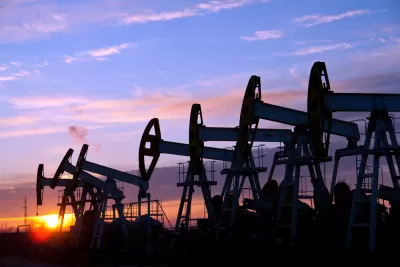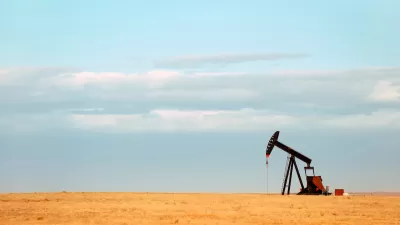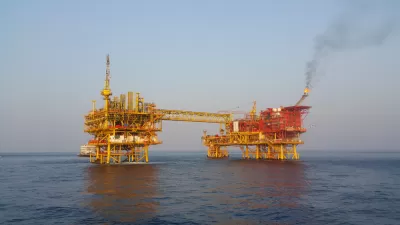A surge of oil from four countries—Norway, Guyana, Canada and Brazil—will more than compensate for slowing growth of U.S. oil production. The new sources might cause oil prices to dip to $50 a barrel and slow the transition to electric vehicles.

"The flood of crude will arrive even as concerns about climate change are growing and worldwide oil demand is slowing," reports
And it is not coming from the usual producers, but from Brazil, Canada, Norway and Guyana — countries that are either not known for oil or whose production has been lackluster in recent years.
The new rise in production is likely to bring economic relief to consumers at the gas pump and to importing nations like China, India and Japan. But cheaper oil may complicate efforts to combat global warming and wean consumers and industries off their dependence on fossil fuels, because lower gasoline prices could, for example, slow the adoption of electric vehicles.
Years of moderate gasoline prices have already increased the popularity of bigger cars and sports utility vehicles in the United States [and globally], and the probability of more oil on the market is bound to weigh on prices at the pump over the next few years.
Daniel Yergin, the energy historian who wrote “The Prize: The Epic Quest for Oil, Power and Money,” compared the impact of the new production to the advent of the shale oil boom in Texas and North Dakota a decade ago.
There is already a glut on the world market, even with exports from Venezuela and Iran sharply curtailed by American sanctions. Should their production come back, that glut would only expand.
Speaking of the American shale oil boom, it appears to have entered the "bust" phase of the notorious fossil fuel energy cycle.
"The downturn in shale drilling has been so steep and brisk that oilfield companies are taking the unprecedented step of scrapping entire fleets of fracking gear," reports Bloomberg's David Wethe on Oct. 30. In a separate piece on Nov. 5, he co-writes that the bust may affect shale gas drilling as well due to low natural gas prices.
"American oil executives express concern that [oil] drilling will fade in North Dakota, Oklahoma, Louisiana and Colorado as oil prices drop to as low as $50 a barrel in the next few years," adds Krauss. "Small companies are expected to merge, while others go bankrupt."
Notwithstanding oil companies' financial woes, production is still projected to increase, albeit at a slower pace, due in part to new pipelines in Texas that are "expected to increase United States exports to 3.3 million barrels a day next year, from the current 2.8 million."
Scott D. Sheffield, chief executive of the Texas-based producer Pioneer Natural Resources, said he expected the growth of United States oil production to ease from 1.2 million barrels a day this year to 500,000 barrels next year and perhaps 400,000 barrels in 2021. Those increases are modest compared with the average increase of a million barrels a day every year from 2010 to 2018.
Last year, global oil production exceeded 100 million barrels per day, according to the U.S. Energy Information Administration. The U.S. was the top producer, with almost 18 million b/d (including petroleum liquids and biofuels), followed by Saudi Arabia and Russia, at 12.42 million b/d and 11.40 million b/d, respectively.
FULL STORY: Flood of Oil Is Coming, Complicating Efforts to Fight Global Warming

Study: Maui’s Plan to Convert Vacation Rentals to Long-Term Housing Could Cause Nearly $1 Billion Economic Loss
The plan would reduce visitor accommodation by 25% resulting in 1,900 jobs lost.

Alabama: Trump Terminates Settlements for Black Communities Harmed By Raw Sewage
Trump deemed the landmark civil rights agreement “illegal DEI and environmental justice policy.”

Why Should We Subsidize Public Transportation?
Many public transit agencies face financial stress due to rising costs, declining fare revenue, and declining subsidies. Transit advocates must provide a strong business case for increasing public transit funding.

Paris Bike Boom Leads to Steep Drop in Air Pollution
The French city’s air quality has improved dramatically in the past 20 years, coinciding with a growth in cycling.

Why Housing Costs More to Build in California Than in Texas
Hard costs like labor and materials combined with ‘soft’ costs such as permitting make building in the San Francisco Bay Area almost three times as costly as in Texas cities.

San Diego County Sees a Rise in Urban Coyotes
San Diego County experiences a rise in urban coyotes, as sightings become prevalent throughout its urban neighbourhoods and surrounding areas.
Urban Design for Planners 1: Software Tools
This six-course series explores essential urban design concepts using open source software and equips planners with the tools they need to participate fully in the urban design process.
Planning for Universal Design
Learn the tools for implementing Universal Design in planning regulations.
Smith Gee Studio
Alamo Area Metropolitan Planning Organization
City of Santa Clarita
Institute for Housing and Urban Development Studies (IHS)
City of Grandview
Harvard GSD Executive Education
Toledo-Lucas County Plan Commissions
Salt Lake City
NYU Wagner Graduate School of Public Service




























